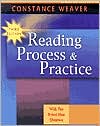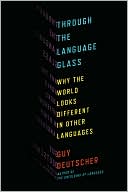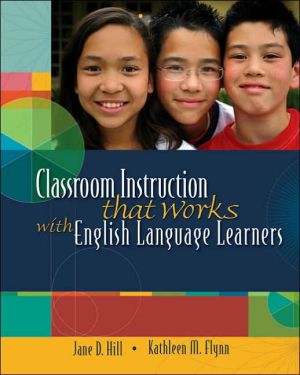Reading Process and Practice
Weaver incorporates especially timely information-accurate data, informed critique, and results of often-ignored research-to help teachers counteract government and corporate intrusion into classrooms.
Search in google:
Authoritative. Comprehensive. Definitive. Reading Process and Practice, since its original publication in 1988, has helped countless preservice and practicing teachers better understand the reading process and translate it into classroom practice-so much so that the book has become the essential guide for teachers. Now, internationally recognized researcher and educator Constance Weaver has thoroughly updated her book. Clarifying theory with explanations and examples, as always, Weaver incorporates especially timely information-accurate data, informed critique, and results of often-ignored research-to help teachers counteract government and corporate intrusion into classrooms. Effective instruction stems from a sensitive, informed response to students' needs; the aim of this book is to help teachers achieve that goal.To that end, Weaver has written five new chapters on assessing and helping readers-enough information to do miscue analysis successfully, to develop a reader profile, and to carry out instructional support for individual readers. To make the book accessible to both undergraduate and graduate students, as well as to new and veteran teachers, she has included definitions and concepts that are repeated throughout the book to provide multiple entry points into key understandings and issues. A new chapter describes what a comprehensive literacy program might include and how it might be structured, while practical chapters flesh out specific components of such a program. Finally, the book is designed so that teachers and teacher educators can cluster chapters in alternative orderings, depending upon the literacy programs in which they teach or the nature of the courses they are teaching.And there's another new and special addition. An associated website contains an extensive bibliography compiled and annotated by first-grade teacher Catherine Compton-Lilly. Numerous sections cover topics that range from being a teacher, choosing books for children, and working with parents to teaching reading in elementary, middle, and high school. Purchasers of the book can download this information-and more-for free at www.heinemann.com/weaver.
Prefacexv1Definitions of Reading: They Make a Difference1The Importance of a Definition1Characterizing Reading and Reading Instruction4Activity 1Activity 2Activity 3For Further Exploration102Schemas and Transactions in the Reading Process14Comprehending and Learning to Read14The Meaning of Words and Sentences: A First Look15Schemas: What Are They?17Schemas in Reading19Schemas and Transactions21Pragmatics: Situational, Social, and Cultural Factors in Reading24Transactions Within the Language of the Text: Grammatical Signals27Surface Versus Deep Structure29Contrasting Models of Reading and Learning to Read32Comprehending Language in ReadingA Skills View of Reading and Learning to ReadA Transactional, Sociopsycholinguistic View of Reading and Learning to ReadFor Further Exploration383Contexts and Strategies in the Reading Process41The Varieties of Context: An Overview41Context Beyond the Sentence and the Text44Using Context to Determine Meaning and Acquire VocabularyUsing Context to Identify WordsContext Within the Sentence49Language Cues and Reading Strategies52Context in Reading: Review and Preview54For Further Exploration574What Miscues Tell Us About Reading and Readers: Reciprocal Insights61Reading Proficiency and the Use of Context62Miscues on Basic Sight WordsConstructing Meaning and Reconstructing TextGood Versus Less Proficient Readers' Use of ContextWhy Not Word Identification?71Words as SymbolsConstructing Meaning Without All the WordsConstructing Meaning and Forgetting the WordsImplications for Understanding Dialect Miscues74Revaluing Readers77Review and Beyond80For Further Exploration815Word Perception in the Reading Process88The Eyes and the Brain89Parts of Words at Work91Activity 1Activity 2Activity 3Parts of Words in ReviewHow We Perceive Words94Activity 1Activity 2Syllables: A Perceptually Salient UnitMore on Reading by Analogy99The Role of Phonics Rules in the Reading Process101Word Parts and Word Perception in Review104Eye Movement and Eye Fixation Studies and the Perception of Words105Popular Claims by Oft-Cited ResearchersEye Fixation ResearchProficient Reading: "Flow" Rather than "Fluency"110Towards a More Complete Model of the Reading Process111For Further Exploration1166Understanding What Miscues Can Tell Us About Readers' Strategies120What We Can Learn by Analyzing Miscues121Miscue Markings122SubstitutionInsertionOmissionPartialReversalCorrectionUnsuccessful Attempt at CorrectionAbandoning a Correct ResponseRepetitionPauseSounding OutMumbleMiscues That Reflect Good Strategies125Miscues That Reflect Good PredictionMiscues Involving Pronouns and Function WordsMiscues That Reflect Readers' Language PatternsImmature Speech PatternEthnic, Social, or Regional DialectESL-Related and EFL-Related MiscuesMiscues That Result from Monitoring ComprehensionRestructuringsRegressions to CorrectRepetitions and PausesMiscues That Suggest Inefficient Reading133Overcorrection of MiscuesMiscues That Suggest Ineffective Reading135The Use of Graphic Cues in Relation to Other Cues136Effective Use of Graphic Cues Along with Other CuesUnderuse of Graphic CuesOveruse of Graphic Cues and Underuse of Other CuesRelated but Different Approaches to Miscue Analysis138Miscue Analysis in the Goodman TraditionCrucial Differences Between Miscue Analysis and Running RecordsFor Further Exploration1447Analyzing Miscues and Looking for Patterns155Miscues and the Use of Context156Marking and Coding Miscues on the Selection Copy161Coding the MiscuesAnalyzing, Coding, and Interpreting the Data from Tony's Miscues163Analyzing and Coding Tony's MiscuesInterpretation of Tony's Miscue PatternsAnother Way of Coding Tony's MiscuesMarking Miscues for Coding168How to Mark Miscues on the Selection CopyGeneral Principles and Procedures for Coding Miscues170Question 1Did the miscue reflect the speaker's ordinary speech patterns?Question 2Did the miscue go with the grammar and meaning of what came before?Question 3Did the miscue go with the grammar and meaning of what followed?Question 4Did the miscue leave the essential meaning of the sentence intact?Question 5Was the miscue corrected?Question 6Was the miscue graphically similar?Question 7Was the sentence, as the reader finally left it, semantically acceptable within the whole original selection that was read?Alternative Miscue Analysis Procedures and Forms175Analyzing Jay's Miscues179Interpretation of Jay's Miscue PatternsFor Further Exploration1838Developing a Reader Profile: From Assessment to Instruction184The Reading Interview and the First Session185The Reading InterviewPreparing for and Conducting the First SessionRecording the Data from the InterviewPreparing for and Conducting the Second Session191Preparing for the ReadingPreparing for the Retelling and Extended DiscussionPreparing to Ask Questions About a StoryConducting the Oral Reading and RetellingDiscussionRecording the Retelling DataRecording the Miscues on the Selection CopyCoding the Miscues and Analyzing PatternsDeveloping a Reader Profile: Tangling with the Messiness of Reality200The Reading InterviewThe Retelling and DiscussionMiscues, Miscue Patterns, and Reading StrategiesAn Instructional PlanAdditional Forms for Recording Data208Other Aspects of a Reading Portfolio and Profile211For Further Exploration2119Revaluing Readers, Retrospective Miscue Analysis, and Other Strategies for Helping Readers212Phonics, Words, and Reading213Efficient Reading and Fluency214Revaluing Readers215Erica: From Analysis to Assistance216Analyzing Erica's MiscuesHelping Erica Revalue Herself as a ReaderRetrospective Miscue Analysis221Teachers Choosing the Miscues for DiscussionReaders Selecting Their Own Miscues for DiscussionRetrospective Miscue Analysis with Pairs or GroupsThe "Think-Aloud" Strategy226Helping Readers Develop Needed Concepts, Vocabulary, and Strategies227Extra Help Through Shared Reading and Constructive Reading Strategies228For Further Exploration23010Addressing Students' Needs in a Comprehensive Literacy Program231Major Components of a Comprehensive Literacy Program232Other Literacy Experiences for Readers in Need235Language Experience and Guided WritingBooks on TapeSupport from Another ReaderUnrehearsed Reading: The Pitfalls of "Round-Robin" ReadingChoral Reading and Readers TheaterChoosing Appropriate Texts242Matching Instruction to Readers' Varied Needs243In Conclusion249For Further Exploration25011Reading Research from Differing Perspectives251Research from a Skills Perspective253An Attempt to Achieve Consensus: Preventing Reading Difficulties in Young ChildrenBefore the National Reading Panel Report: Critiques of the Skills ResearchThe National Reading Panel ReportOther Critiques of the NRP Report and Its MethodologyResearch from a Comprehensive Literacy Perspective262Research on "Decodable" TextsClassroom Research on the Effects and Effectiveness of Comprehensive Literacy ProgramsAcquiring Literacy in a Second Language Through Book-Based ProgramsObservational Research from the Center on English Learning and AchievementFor Further Exploration27512Designing a Comprehensive Literacy Program276Guiding Principles and Practices278Reading and Writing Workshops: The Heart of a Comprehensive Literacy Program280Reading WorkshopsAssessmentWriting WorkshopsHow Might We Organize a Classroom Literacy Program?298Comments on the Sample SchedulesFor Further Exploration30313Research on Learning and Teaching Phonics304Clarifying Some Concepts and Terms305Phonological AwarenessPhonics, "Phonics Knowledge," and DecodingLetter-Sound Knowledge in Learning to Read Words310Reading Words by AnalogyDevelopmental Patterns in ReviewRelationships Between Phonemic Awareness and Learning to Read314Phonemic Awareness Promotes Learning to ReadLearning to Read Promotes Phonemic AwarenessLearning to Read and Phonemic Awareness Facilitate Each OtherThe National Reading Panel Report on Phonics317Major Distortions in the Summary of the NRP ReportInterpreting NRP Claims About Reading GrowthNegative or No Conclusions from the NRP Subgroup Report on PhonicsSummary of Actual NRP FindingsConsiderations and CautionsFor Further Exploration32414Teaching Comprehension Strategies and Phonics Skills325Teaching Reading Strategies at the Macro Level327Teaching Strategies in the Primary GradesTeaching Strategies in the Intermediate and Middle GradesTeaching Reading Strategies at the Micro Level333A Reading Detective ClubConsidering Strategies for Dealing with WordsUsing Prompts and Developing Strategy Charts and BookmarksTeaching Phonics and Phonemic Awareness343The Shared Reading Experience--and MoreIntensive, Systematic PhonicsA Perspective on Teaching PhonicsAnd Let Us Keep in Mind...359So Let Us Not Forget...For Further Exploration35915Foundations for Universal Literacy, by Margaret Moustafa365Early Readers365Early Reading Instruction369Beyond Decoding373Beyond Instruction374Towards Universal Literacy376For Further Exploration377Notes379References385Index417








